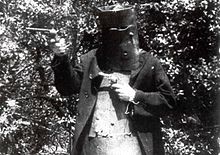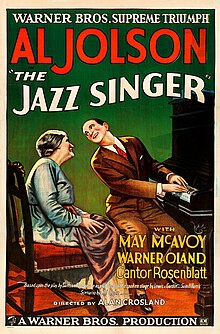Feature film
Afeature filmorfeature-length film(often abbreviated tofeature), also called atheatrical film,is anarrative film(motion pictureor "movie" ) with a running time long enough to be considered the principal or sole presentation in a commercial entertainment program. The termfeature filmoriginally referred to the main, full-length film in a cinema program that included ashort filmand often anewsreel.Matinee programs, especially in the US and Canada, in general, also includedcartoons,at least one weeklyserialand, typically, a second feature-length film on weekends.
The first narrative feature film was the 60-minuteThe Story of the Kelly Gang(1906, Australia).[1]Other early feature films includeLes Misérables(1909, U.S.),L'Inferno,Defence of Sevastopol(1911),Oliver Twist(American version),Oliver Twist(British version),Richard III,From the Manger to the Cross,Cleopatra(1912),Quo Vadis?(1913),Cabiria(1914) andThe Birth of a Nation(1915).
Description
[edit]The notion of how long a feature film should be has varied according to time and place. According to theAcademy of Motion Picture Arts and Sciences,[2][3]theAmerican Film Institute[4]and theBritish Film Institute,[5]a feature film runs for more than 40 minutes, while theScreen Actors Guildasserts that a feature's running time is 60 minutes or longer.[6][7]TheCentre National de la Cinématographiein France defines it as a35 mm filmlonger than 1,600 metres (5,200 ft), which is exactly 58 minutes and 29 seconds forsound films.[8]
History
[edit]
The termfeature filmcame into use to refer to the main film presented in a cinema and the one which was promoted or advertised. The term was used to distinguish the longer film from theshort films(referred to as shorts) typically presented before the main film, such asnewsreels,serials,animated cartoons,live-action comedies anddocumentaries.There was no sudden increase in the running times of films to the present-day definitions of feature-length; the "featured" film on a film program in the early 1910s gradually expanded from two to three to four reels. Early features had been produced in the United States and France, but were released in individual (short film) scenes. This left exhibitors the option of playing them alone, to view an incomplete combination of some films, or to run them all together as a short film series.
Early features were mostly documentary-style films of noteworthy events. Some of the earliest feature-length productions were films of bo xing matches, such asThe Corbett-Fitzsimmons Fight(1897),[9]Reproduction of the Corbett-Jeffries FightandThe Jeffries-Sharkey Fight(1899). Some consider the 100-minuteThe Corbett-Fitzsimmons Fightto be the first documentary feature film, but it is more accurately characterized as a sports program as it included the full unedited bo xing match. In 1900, the documentary filmArmy Lifewas produced byRobert Paul.It was a programme of 33 short films, with a total running time of around 75 minutes, following the training of British soldiers.[10]Inauguration of the Australian Commonwealth(1901) ran for 35 minutes, "six times longer than any previous Australian film",[11]and has been called "possibly the first feature-length documentary made in Australia".[12]American companyS. Lubinreleased aPassion PlaytitledLubin's Passion Playin January 1903 in 31 parts, totaling about 60 minutes.[13]The French companyPathé Frèresreleased a different Passion Play in May 1903,The Life and Passion of Jesus Christ,in 32 parts, totaling 44 minutes.
Defined by length, the first dramatic feature film was theAustralian60-minute filmThe Story of the Kelly Gang(1906).[14]Similarly, the first European feature was the 90-minute filmL'Enfant prodigue(France, 1907), although that was an unmodified record of a stage play; Europe's first featureadapted directly for the screen,Les Misérables[better source needed],came from France in 1909.[14]The first Russian feature wasDefence of Sevastopolin 1911.[15]Early Italian features includedL'Inferno(1911),Quo Vadis?,The Last Days of Pompeii(1913) andCabiria(1914). The first UK features were the documentaryWith Our King and Queen Through India(1912), filmed inKinemacolor[16]andOliver Twist(also 1912).[14]The first American features wereOliver Twist,From the Manger to the Cross,CleopatraandRichard III(all 1912). ActorFrederick Wardestarred in some of these adaptations.[17]The firstAsian featurewasJapan'sThe Life Story of Tasuke Shiobara(1912),[18]the firstIndian featurewasRaja Harishchandra(1913),[19]China's first feature film was Zhang Shichuan'sNan Fu Nan Qi(1913), the firstSouth Americanfeature wasBrazil'sO Crime dos Banhados(1913),[18]and the firstAfricanfeature wasSouth Africa'sDe Voortrekkers(1916).[18]
By 1915, over 600 feature films were produced annually in the United States.[20]It is often incorrectly cited thatThe Birth of a Nation(1915) was the first American feature film.[21]The most prolific year of U.S. feature production was 1921, with 682 releases; the lowest number of releases was in 1963, with 213.[20]Between 1922 and 1970, the U.S. and Japan alternated as leaders in the quantity of feature film production. Since 1971, the country with the highest feature output has been India,[22]which produces a thousand films in more than twelveIndian languageseach year.[23]
Technological developments
[edit]
In 1927,Warner Bros.released the first feature-length film with sound,The Jazz Singer,whose audio track was recorded with a proprietary technology calledVitaphone.[24]The film's success persuaded other studios to go to the considerable expense of adding microphones to their sets, and scramble to start producing their own "talkies".[25]
One of the next major advancements made in movie production wascolor film.Even before color was a possibility in movies, early film makers were interested in how color could enhance their stories.[26]Early techniques includedhand tinting:painting each frame by hand.[26]Cheaper and more widely used wastoning:dying the film in a single color, used in many films in the 1920s.[26]The film processing labTechnicolordeveloped the Three-Tone coloring technique that became the standard for color film. It was a complex, time consuming, and expensive process that many movie studios were not eager to try.[27]One of the early adopters of the three-strip process wasDisney.Some of the most notable filmsTechnicolorprocessed with three-strip wereThe Wizard of OzandGone with the Wind.[26]
This sectionneeds expansionwith: The influence from TV after World War 2 (wide screen and surround sound). You can help byadding to it.(August 2020) |
Digital Video(or DV) has quickly changed how most films are made.[28]First used to create special effects and animated movies, digital cameras became more common on film sets in the late 1990s. In 2002,George Lucas'Star Wars: Episode II – Attack of the Clonesbecame the first major studio film shot primarily on digital video. The ability to instantly play back footage and quickly transfer footage to computers for editing helped to speed up post-production time.[28]Digital film making was given a big boost in 2005 when theDigital Cinema Initiativecreated a guide for manufacturers to create a universal standard, to make the technologies more compatible with each other and more user friendly.[28][29]Shooting movies on digital also led to new technologies for distributing films.Titan A.E.,released in 2000, was the first feature film to be released for viewing over the internet.[29]Digital distribution changed the ways people received and watched media. It also gave viewers access to huge amounts of online content on demand.[30]
See also
[edit]- Narrative film
- Short film
- Featurette
- List of early color feature films
- List of motion picture terminology
References
[edit]- ^"The Story of the Kelly Gang (1906)".Australian Screen.RetrievedMay 26,2014.
- ^"93rd Academy Awards of Merit rules"(PDF).Oscars.org.Academy of Motion Picture Arts and Sciences.Archived(PDF)from the original on May 2, 2020.RetrievedFebruary 18,2021.
- ^"Rule 2 | 79th Academy Awards Rules | Academy of Motion Picture Arts and Sciences".Archived from the original on September 6, 2008.RetrievedNovember 24,2006.
{{cite web}}:CS1 maint: bot: original URL status unknown (link) - ^The American Film Institute Catalog of Motion Pictures
- ^"FAQ".British Film Institute.RetrievedAugust 27,2018.
- ^"SCREEN ACTORS GUILD AWARDS ELIGIBILITY MOTION PICTURES".RetrievedNovember 22,2021.
- ^"SCREEN ACTORS GUILD MODIFIED LOW BUDGET AGREEMENT"(PDF).Archived from the original on December 29, 2009.RetrievedDecember 10,2008.
{{cite web}}:CS1 maint: bot: original URL status unknown (link) - ^"Diffusion non commerciale | CNC".cnc.fr(in French).RetrievedApril 12,2024.
- ^Charles Musser,The Emergence of Cinema: The American Screen to 1907,pp. 197–200.
- ^Robert Paul and the Origins of British Cinema,University of Chicago Press, 2019, pp. 157–160,doi:10.7208/chicago/9780226610115.003.0012,ISBN978-0-226-10563-5,S2CID239321837,retrievedAugust 9,2021
- ^"Inauguration of the Commonwealth (1901): Education notes".Australian Screen.RetrievedJanuary 8,2019.
- ^"Inauguration of the Commonwealth (1901)".Australian Screen.RetrievedJanuary 8,2019.
- ^Passion Play(1903), in: The American Film Institute Catalog of Motion Pictures [online database].
- ^abcRobertson, Patrick (2001).Film Facts.New York: Billboard Books. p. 9.ISBN0-8230-7943-0.RetrievedSeptember 13,2022.
- ^Patrick Robertson,Film Facts,New York: Billboard Books, 2001, p. 13.ISBN0-8230-7943-0.
- ^Charles Urban,A Yank in Britain: The Lost Memoirs of Charles Urban, Film Pioneer,The Projection Box, 1999, p. 79.ISBN978-0-9523941-2-9.
- ^Patrick Robertson,Film Facts,New York: Billboard Books, 2001, p. 10.ISBN0-8230-7943-0.
- ^abcPatrick Robertson,Film Facts,New York: Billboard Books, 2001, pp. 10–14.ISBN0-8230-7943-0.
- ^Patrick Robertson,Film Facts,New York: Billboard Books, 2001, p. 12.ISBN0-8230-7943-0.
- ^abAmerican Film Institute Catalog of Motion Pictures [online database].
- ^"'The Birth of a Nation' was the first feature and the first film shown at the White House."Movies Silently.Sept. 2015. September 2. 2017.http://moviessilently /2015/09/07/silent-movie-myth-the-birth-of-a-nation-was-the-first-feature-and-the-first-film-shown-at-the-white-house/
- ^Patrick Robertson,Film Facts,New York: Billboard Books, 2001, p. 15.
- ^Nelmes, Jill (2003), "10",An introduction to film studies(3rd ed.),Routledge,p. 360,ISBN0-415-26268-2
- ^Carringer, Robert L (1979).The Jazz Singer.Wisconsin: Univ of Wisconsin Press. p.17.ISBN978-0299076641.
- ^Parkinson, David (April 18, 2012)."100 Ideas That Changed Film: Sound".Credo Reference.Laurence King.RetrievedOctober 21,2016.
- ^abcdParkinson, David (April 18, 2012).""Color" 100 Ideas That Changed Film ".Credo Reference.Laurence King.RetrievedOctober 21,2016.
- ^Kroon, Richard W. (2010).""Technicolor." A/v A to Z: An Encyclopedic Dictionary of Media, Entertainment and Other Audiovisual Terms ".Credo Reference.McFarland.RetrievedOctober 22,2016.
- ^abcParkinson, David (2012).""Digital Video." 100 Ideas That Changed Film ".Credo Reference.RetrievedNovember 24,2016.
- ^abKroon, Richard W. (2014)."Digital Cinema; A/v A to Z: An Encyclopedic Dictionary of Media, Entertainment and Other Audiovisual Terms".Credo Reference.McFarland.RetrievedNovember 24,2016.
- ^Curtin, Michael; Holt, Jennifer & Sanson, Kevin (2014).Distribution Revolution: Conversations about the Digital Future of Film and Television.Berkeley, US: University of California Press. p. 165.ISBN9780520959088.
